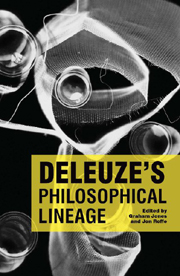Book contents
- Frontmatter
- Contents
- Acknowledgements
- List of Abbreviations
- Introduction: Into the Labyrinth
- 1 Plato
- 2 John Duns Scotus
- 3 G. W. F. Leibniz
- 4 David Hume
- 5 Immanuel Kant
- 6 Solomon Maimon
- 7 G. W. F. Hegel
- 8 Karl Marx
- 9 Hoëne Wronski and Francis Warrain
- 10 Bernhard Riemann
- 11 Gabriel Tarde
- 12 Sigmund Freud
- 13 Henri Bergson
- 14 Edmund Husserl
- 15 A. N. Whitehead
- 16 Raymond Ruyer
- 17 Martin Heidegger
- 18 Pierre Klossowski
- 19 Albert Lautman
- 20 Gilbert Simondon
- Bibliography
- Notes on Contributors
- Index
Introduction: Into the Labyrinth
Published online by Cambridge University Press: 12 September 2012
- Frontmatter
- Contents
- Acknowledgements
- List of Abbreviations
- Introduction: Into the Labyrinth
- 1 Plato
- 2 John Duns Scotus
- 3 G. W. F. Leibniz
- 4 David Hume
- 5 Immanuel Kant
- 6 Solomon Maimon
- 7 G. W. F. Hegel
- 8 Karl Marx
- 9 Hoëne Wronski and Francis Warrain
- 10 Bernhard Riemann
- 11 Gabriel Tarde
- 12 Sigmund Freud
- 13 Henri Bergson
- 14 Edmund Husserl
- 15 A. N. Whitehead
- 16 Raymond Ruyer
- 17 Martin Heidegger
- 18 Pierre Klossowski
- 19 Albert Lautman
- 20 Gilbert Simondon
- Bibliography
- Notes on Contributors
- Index
Summary
Those coming to Deleuze's work for the first time (and even those returning to it anew) find themselves confronted by the dilemma of where to begin, of how to engage with it. Two difficulties present themselves. The first and more immediate one is that, conceptually, Deleuze's work is so richly detailed and complex. Thus on opening one of his books the reader is confronted by a plethora of concepts that already seem to presuppose on the reader's part an intimate familiarity with numerous other related concepts, theories, or thinkers. It is akin, perhaps, to a labyrinth in which one can easily become lost, or frustratingly disheartened at the prospect of navigating such a complex architecture.
This leads into the second, more dangerous, difficulty – the place of commentary in respect to such an encounter. Readers will, not unreasonably, peruse existing interpretations in search of guidance in relation to Deleuze's philosophy. But whatever reassurance they find will often prove misleading, for in the field that can, more or less, be called Anglo-American ‘Deleuze Studies’, an orthodoxy seems to have installed itself. This orthodoxy or ‘Image of [Deleuzian] Thought’ has multiple sources, and as a result requires detailed elaboration. In the first instance, it was the case for a long time that few of Deleuze's texts were available in English translation, making it difficult to determine any larger or more accurate ‘perspective’ on Deleuze's project.
- Type
- Chapter
- Information
- Deleuze's Philosophical Lineage , pp. 1 - 7Publisher: Edinburgh University PressPrint publication year: 2009



